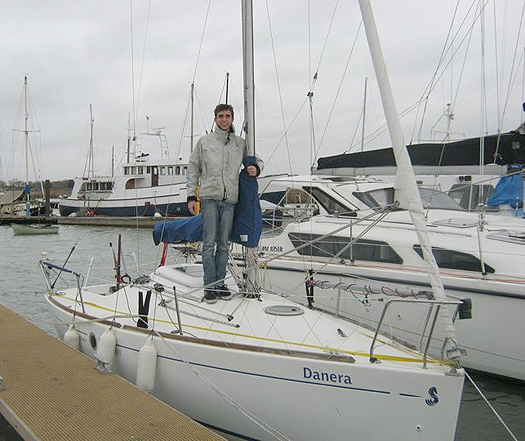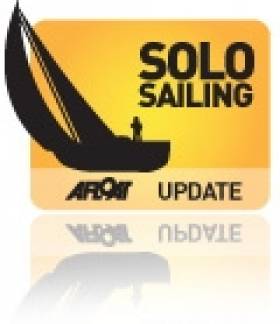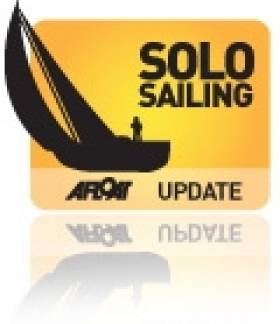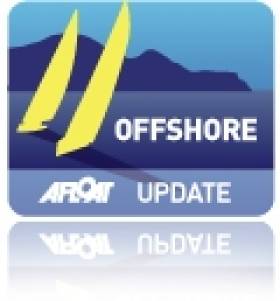Displaying items by tag: solo
Tom Webb Sail Around Britain Challenge
Seventeen-year-old Tom Webb is poised to sail solo round Britain in his Hyde Sails-powered Beneteau First 211 'Danera'.
Tom believes sailing is a sport to be enjoyed by people of all abilities and to highlight the opportunities in sailing, particularly for disabled young people, on July 2 he will set off on his solo sail round Britain.
Tom explains: 'In doing the challenge I want to show my support for three fantastic charities: Phil Packer's British Inspiration Trust (BRIT), Even Keel and RYA Sailability at Langstone SC. Phil Packer is one of the most inspirational people I have met, who has an incredible mission with BRIT to create a
centre of inspiration for disabled young people in the Chichester area. Also, as a young person I want to challenge myself by drawing from the inspiration of the young disabled people I have met through the Even Keel sailing charity. They have challenges just in their daily lives, but also strive to set themselves new goals.'
The skipper
Tom Webb has been on and around boats all his life. 'My first dinghy was a bright yellow wooden Mirror dinghy,' he recalls. 'I then moved to Toppers and more recently I started racing a 420. Over the last couple of years I have been really lucky to have worked with the Even Keel Project and have taken part in racing events with them, including the fantastic Artemis Even Keel Challenge at Cowes in 2010.' This was where his solo sailing started: 'During this time I was becoming motivated to push my singlehanded ambitions, I began to explore the idea of sailing around Britain.
Through some luck, and the sale of the family Iroquois catamaran in 2009, "Danera" was bought as a yacht on which I could get experience of singlehanded keelboat sailing with a sail around Britain in the Summer of 2011 in mind.'
The boat and sails 'Danera' is a 21ft drop keel monohull. 'It's a fast boat that wouldn't be other people's first choice when sailing round Britain,' says Tom, 'Although hard work to keep going, she is rewarding to sail in all weather. She's topped out at 13 knots planing down a wave with the kite up - but I don't intend to push any where near as hard for the trip!' His new sails are from Hyde: ''The new fully battened main and genoa are a fantastic addition to the boat, they provide the power and
durability needed for long passages, but still give great responsive performance for racing around the cans.'
The Trip
Starting from Portsmouth on July 2, Tom will sail anti-clockwise stopping at 28 ports along the way. He will sail through the Caledonian canal, rather than round the top of Scotland as the trip needs to fit into his summer break between college and university. 'I will be sailing on average eight hours a day and hope to complete the trip in one and a half months.'

For more information on the project see www.tomwebbsailing.com
Golding Goes for Fourth Start in Vendee Globe Race
Gamesa, a global wind power technology leader and a world reference in the development and sale of wind farms, and UK solo sailor Mike Golding, OBE, have today announced their intention to be on the start line of the 2012 Vendee Globe in Les Sables d'Olonne, France, on 10 November 2012 with the IMOCA Open 60 Gamesa.
The race emerges as this new partnership's most important challenge, Gamesa having revealed its sponsorship of the Gamesa Sailing Team, led by Mike Golding, to 135 of its top global executives at their annual convention in Windsor, England.Billed as 'the Everest of yacht racing', this will be the fourth start for the Hampshire, UK, based skipper; something he himself describes as 'unfinished business'.
"This sponsorship comes at an important time for Gamesa and our planned programme of expansion into the offshore market in UK," Jorge Calvet, Chairman and Chief Executive of Gamesa announced. "The sea and the wind are similarly part of the Gamesa challenge and there are synergies between Mike's Vendée Globe campaign and our own activities in the wind power market in the UK and globally. We have a vigorous business plan over the coming years with many common values, including innovation, teamwork, leadership and passion for our customers, and we look forward to working with Mike and his team to achieve both our goals and his," he concluded.
Gamesa is ready to play a significant role in the offshore market. The company is working to launch two offshore platforms (the G11X-5.0 MW and G14X-6/7 MW) and it has also announced that the UK will be the centre of its offshore wind business. It plans to invest over €150 million there by 2014. It will establish an offshore technology centre in Glasgow and will analyse the development of manufacturing, port logistics and O&M capabilities in several UK ports (England and Scotland). Gamesa's offshore business will be headquartered in London.
Mike Golding is one of the world's most accomplished solo ocean sailors. With over 250,000 racing miles and some 25 equator crossings, he has competed in three previous Vendée Globes, held three world championship titles and created a reputation for being "King of the South", setting the fastest speed record in the Southern Ocean.
Golding commented, "This is obviously fantastic for us to be able to formally announce our partnership with Gamesa. With Gamesa's support and our existing infrastructure we are now certain to be able to mount a very competitive campaign for the 2012 Vendée Globe – which is simply wonderful news. Having enjoyed enormous success in the sport of sailing, the Vendee Globe remains 'the event' I would most love to win."
"Furthermore, having spent the past decade championing environmental products and issues, it is really exiting that Gamesa's core business is in renewable energy – an area increasingly critical to performance in competitive round the world yacht racing."
Mike Golding's Owen Clark-designed Open 60 is currently undergoing some major optimisation work in the UK, with a view to being on the water again later this summer. The first major event for the team will be the double-handed Transat Jacques Vabre from France to Costa Rica in October 2011.
During May 2012 the Gamesa IMOCA 60 will race fully crewed in the Europa Race (a tour of Europe) before the team makes final preparations for the non-stop solo around the world race, the Vendée Globe.
Shooter Hits Tramore Three Weeks Into Kayak Challenge
Elaine 'Shooter' Alexander has now reached Tramore on the south-east coast in her effort to circumavigate the island of Ireland by kayak.
Now three weeks into her solo voyage to raise funds for Share, which works for the inclusion of disabled people in water-based and other activities, Shooter is edging ever closer to the half-way point of her 1,000-mile route.
See below for a map of Shooter's current position.
Solo Sailing Conference Offers Charter of Performance Yachts
Irish solo sailing fans may be interested in the annual Solo Racing Festival at the Royal Southern Yacht Club, Hamble on Saturday 12th March.
Given the Figaro race is coming to Dun Laoghaire in August a talk on the Artemis Academy with John Thorn (Figaro 2) will be of particular interest.
Owen Clarke's designer Merfyn Owen, who lives in Hamble will be attending as well as colleagues from their brokerage partners Boatshed Performance.
So whether your interest be solo sailing or short-handed sailing in general they will be there to answer questions on design, construction, as well as sale/purchase and charter of offshore performance yachts.
The Race Fair is an open house from 10.00 for race organisers to meet and greet potential skippers from; Global Ocean/Class 40, Mocra, UK mini group, RORC, SORC, Biscay Challenge, AZAB. Floating boat show, 8 boats including the OC class 40, 2 minis, A35, J105, Figaro 2, Sunfast 3200.
There is a Book Signing, Alex Bennett signing copies of High Seas High Stakes and showing Fuji DVD Mike Golding is opening the talks at 11,00.
Followed by:
Winning Mind Set with Ian Brown, sports psychologist
Global Ocean race with Oliver Dewar
Two Star/Ostar with John Lewis, RWYC
30m trimaran design with Nigel Irens (Idec, Sodebo)
Artemis Academy first term report with John Thorn (Figaro 2)
Route du Rhum with Marco Nannini, (class 40)
all in the spendid riverside setting of the Royal Southern Yacht Club, Hamble.
More HERE.
Preparing for the Challenge of La Solitaire du Figaro
Dubliner Paul O'Riain's comprehensive article on his Figaro debut experience in 2007 has moved, Click this link for it and the latest La Solitaire du Figaro news.
Irish Mini 6.50 Campaign in Prospect
Double and Solo Racing Group member Michael McKeon is organising an Irish Mini 6.50 campaign. Following the success of the Mini open days sailing on his boat 'Hypomene', McKeon has made a call to all interested parties to ensure the boat is actively campaigned as the 'Irish Mini' during the 2011 calendar! Anyone interested in the Mini 6.50 class and in sampling short-handed racing 'the French way' is welcome. For more click HERE.
First UK Offshore Sailing Academy Squad Selected
From an original list of over 50 applicants, those who made it to the shortlist were put through a grueling mental and physical selection process. They were pushed well beyond their comfort zones with nine ultimately chosen to be part of the Development Squad:
• Oliver Bond (30, Southampton)
• Nick Cherry (25, Birmingham/Southampton)
• Sam Goodchild (20, Southampton)
• Simon Hiscocks (37, Surrey/Portland)
• Nick Houchin (26, Tadley, Hampshire)
• Nigel King (41, Lymington)
• Becky Scott (24, Scotland/Fleet)
• Phil Sharp (29, Jersey)
• Oliver Young (22, Saltash)
As part of the Squad, they will begin a winter-long programme where they will develop the skills needed to perform as a world class offshore sailor. The Academy will be based from the Weymouth and Portland National Sailing Academy until the end of November when they will relocate to La Grande Motte Figaro School (CEM). From here CEM Director Franck Citeau will manage a full programme for the sailors through to the end of March. At that point one of the Squad will be selected for the scholarship which will enable them to race in the 2011 French Figaro circuit in one of the Artemis Figaro boats. The remaining Squad will continue to train and take part in a series of races throughout 2011, including Royal Ocean Racing Club's most famous race the Rolex Fastnet Race, and the Tour du Bretagne at the end of September.
The group will be bolstered by two associate members, 36 year old Pip Hare (Felixstowe) and 37 year old Conrad Humphreys (Plymouth) who, instead of being provided with equipment and costs, will bring their own campaign to train with the Academy. As the project develops, the aim is that more people will move on from the Development Squad to become associate members and keep training with the Academy.
Sailors will remain in the Development Squad for as long as they are attaining pre-agreed training goals. The aim is to allow sailors the time in the Figaro boats to develop their skills before moving into other classes or finding their own funding for a campaign. Further selections to top up the squad will be held in April and September 2011.
Conrad Humphreys commented: "When the Artemis Offshore Academy was announced earlier this year, I immediately thought it was not only a great idea but also the missing link for UK aspiring and seasoned solo sailors. No one would argue that when compared to our French counterparts, we simply do not do enough collaborative training or development in between the major events. The Figaro championship is one of the best programmes for short-handed development and there is no secret to the fact that every Vendée Globe winner maintains close links with the class. I hope the Artemis Offshore Academy will become a place to nurture new talent and provide Associate sailors like myself with support to compete at the top level. I will be looking for a sponsor to do the Solitaire du Figaro in 2011 and the Transat in 2012 and I look forward to working with the rest of the squad over the coming 12 months."
Simon Hiscocks commented: "The British success in the Olympics is a direct result of a very long programme that the RYA has run right from the grass roots getting people learning to sail up to winning Olympic gold medals. And that whole thing has a massive structure behind it - you name it they are on it. Hopefully we can transfer that success into this field through this programme. The Artemis Offshore Academy opens up a whole new world of opportunities, not least of which is potentially being able to do the Vendée Globe, and I am really excited to be part of it."
John Thorn, Artemis Offshore Academy Performance Director commented:
"From their application and CVs, we knew we had the sailors. It was then more a question of trying to identify some of the other traits that we felt were an important part of success in short sailing and offshore sailing. There were lots of elements that we were looking for.
The nine development squad members that we have chosen have got tremendous potential – and we looked at that potential over short, medium and long term. But they are experienced sailors, they are technical competent sailors and they have the desire to win.
We will identify what the sailors need and we will deliver that, using the best coaches, the best venues, the best resources we can. We'll give them everything they need in order to be successful.
I am tremendously optimistic and truly believe, because we are building a foundation for long term success, that we will see an Artemis Offshore Academy sailor on the podium for the Vendée Globe. It is an incredibly exciting time and this is just the beginning."
€10,000 Up for Grabs in Five Oceans Game
Sailing fans and armchair experts can now compete in their own Ultimate Solo Challenge from the comfort of their own homes with the VELUX 5 OCEANS Virtual Regatta game. What's more, there's €10,000 of prize money up for grabs for the best virtual ocean racers over the course of the 30,000-mile solo yacht race.
The virtual regatta game allows players to race their virtual Eco 60 yachts against the skippers as they sail around the world solo. Players can control their virtual yacht's heading and sail plan as well as which angle to the wind the yacht sails at.
Prizes will be given to the top three virtual skippers on each of the five ocean sprints. €10,000 of prize money will be given out over the course of the race. Players can also win a year-long professional subscription to race suppliers PredictWind, a marine weather forecasting tool, worth €500 as well as a year membership to Sailors for the Sea worth $500.
There will also be prizes for the top ten overall. Here's how the prize money will be broken down:
Each ocean sprint:
1st: €700 + 1 year PredictWind professional subscription
2nd: €350 + 1 year Sailors for the Sea membership
3rd: €100 + Sailors for the Sea hat/newsletter
Overall:
1st: €900 + 1 year PredictWind professional subscription + 1 year Sailors for the Sea full membership + Sailors for the Sea hat/newsletter
2nd: €800 + 1 year PredictWind professional subscription + 1 year Sailors for the Sea full membership
3rd: €600 + 1 year PredictWind professional subscription
4th: €500 + 1 year PredictWind professional subscription
5th: €300 + 1 year PredictWind professional subscription
6th – 10th: €200
Polish Entry into Velux 5 Oceans Race
Zbigniew 'Gutek' Gutkowski has moved one step closer to his goal of becoming the first Polish person to race solo around the world after getting his hands on a high-tech Eco 60 yacht for the VELUX 5 OCEANS. Gutek, one of Poland's best known and most experienced sailors, has spent several months carefully choosing the right boat to take him 30,000 nautical miles around the world in The Ultimate Solo Challenge.
Gutek has settled on Globe, formerly Bagages Superior, one of the most proven Eco 60s on the market. The yacht is a former Vendée Globe winner - in 1991 French solo sailing legend and VELUX 5 OCEANS veteran Alain Gautier steered her to glory. Four years later she returned to the Vendée Globe with Eric Dumont, just missing out on a podium place to finish fourth. Globe is also a veteran of three Transat Jacques Vabre races. In 2000 Globe was rebuilt and five years later she was given a complete overhaul, putting her back at the front line of modern racing yachts.
The next step in Gutek's voyage to the start of the race in La Rochelle, France, on October 17 is to set sail on a qualifying passage. Having taken delivery of the yacht earlier this week, Gutek and his Polish Ocean Racing team are now preparing Globe for her first offshore voyage under his command.
Gutek, 36, said: "I am very pleased to be able to sail Globe around the world in the VELUX 5 OCEANS. The search for the right boat for me has been a long one but it was worthwhile as now I have a great boat that I know will perform and I can trust in her. I am looking forward to getting to know the boat better when I take her on the qualifying passage later this month. After that we will carry our final preparations before sailing to La Rochelle to prepare for the start of the VELUX 5 OCEANS."
No stranger to ocean racing, Gutek was a watch captain onboard WARTA-POLPHARMA in The Race, the non-stop race around the world for multihulls. In 2005 he skippered the ORMA 60 Bonduelle in the Nokia Oops Cup. He also attempted to break the monohull record for a non-stop circumnavigation onboard the Volvo 60 Bank BPH (formerly ASSA ABLOY), but damage forced the crew to Cape Town after 9,500 miles.
The VELUX 5 OCEANS, run by Clipper Ventures PLC, is the longest running solo round the world race, and has 28 years of rich heritage as the BOC Challenge and then the Around Alone. This edition features five ocean sprints over nine months. After heading from La Rochelle to Cape Town, the race will then take in Wellington in New Zealand, Salvador in Brazil and Charleston in the US before returning back across the Atlantic to France.





































































